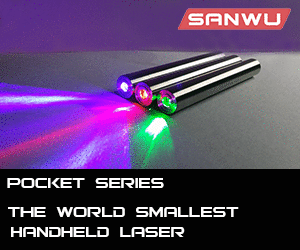
Welcome to Laser Pointer Forums - discuss green laser pointers, blue laser pointers, and all types of lasers
How to Register on LPF | LPF Donations
Navigation
Install the app
How to install the app on iOS
Follow along with the video below to see how to install our site as a web app on your home screen.
Note: This feature may not be available in some browsers.
More options

You are using an out of date browser. It may not display this or other websites correctly.
You should upgrade or use an alternative browser.
You should upgrade or use an alternative browser.
how to measure beam color combination results
- Thread starter iroquois
- Start date


Gadget
0
- Joined
- Dec 28, 2013
- Messages
- 358
- Points
- 43
The tool is called a Spectrometer.
You can make your own for low-powered lasers that will be somewhat accurate. Instructions here. I built one of these and it works very well, but it uses a very cheap diffraction grating from an optical disc (CD/DVD).
Or you can spend up to thousands of dollars for a very accurate one. A search will turn up many options.
-G
You can make your own for low-powered lasers that will be somewhat accurate. Instructions here. I built one of these and it works very well, but it uses a very cheap diffraction grating from an optical disc (CD/DVD).
Or you can spend up to thousands of dollars for a very accurate one. A search will turn up many options.
-G
Last edited:
rhd
0
- Joined
- Dec 7, 2010
- Messages
- 8,469
- Points
- 0
So much wrong with the above...
When you mix two wavelengths with a dichro, you don't get a third unique wavelength as the result. You get a third color (as far as your eyes are concerned) but the wavelengths don't change. You may get a color that looks, to your eyes, like another wavelength (for example when mixing red and green to get yellow) or you may get something that looks, to your eyes, like a color that doesn't match any possible unique wavelength (like when mixing red and blue to get magenta).
Also, while gadget is kind of correct in that he named a tool that identifies wavelengths, that doesn't change the fact that if you mix 650nm and 532nm beams with a dicheo to produce a yellow beam, the spectrometer just sees 650nm and 532nm light, not some new wavelength in between.
When you mix two wavelengths with a dichro, you don't get a third unique wavelength as the result. You get a third color (as far as your eyes are concerned) but the wavelengths don't change. You may get a color that looks, to your eyes, like another wavelength (for example when mixing red and green to get yellow) or you may get something that looks, to your eyes, like a color that doesn't match any possible unique wavelength (like when mixing red and blue to get magenta).
Also, while gadget is kind of correct in that he named a tool that identifies wavelengths, that doesn't change the fact that if you mix 650nm and 532nm beams with a dicheo to produce a yellow beam, the spectrometer just sees 650nm and 532nm light, not some new wavelength in between.
Yes, correct. My mistake. I want to know what color (for our eyes) I'll get. I hope there's some (online?) tool for that.When you mix two wavelengths with a dichro, you don't get a third unique wavelength as the result. You get a third color (as far as your eyes are concerned) but the wavelengths don't change. You may get a color that looks, to your eyes, like another wavelength
Last edited:
rhd
0
- Joined
- Dec 7, 2010
- Messages
- 8,469
- Points
- 0
Yes, correct. My mistake. I want to know what color (for our eyes) I'll get. I hope there's some (online?) tool for that.
There is. It's called Chroma. It's free to download. To head off a common response, the download links aren't all dead, you just have to dig deep into the various forum threads that talk about it.
- Joined
- Jan 5, 2011
- Messages
- 418
- Points
- 28
It is not that simple to get a formula for "color". The scattering is different in atmosphere for different wavelengths (blue sky, red sunset etc). The same size beams have different divergence thus with propagation color might change.
rhd recommended Chroma is a good start.
rhd recommended Chroma is a good start.

